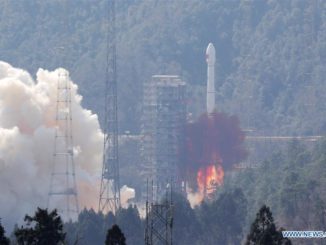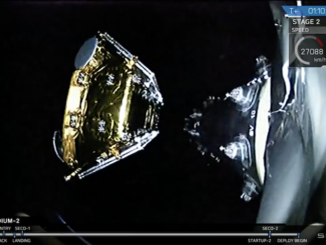
A Soyuz booster and Fregat upper stage successfully delivered an upgraded Russian Glonass navigation satellite to an orbit nearly 12,000 miles above Earth on Saturday.
The new satellite joins 24 active navigation spacecraft in the Glonass fleet, Russia’s analog to the U.S. military’s Global Positioning System.
The mission took off at 3:08:42 p.m. EDT (1908:42 GMT) Saturday aboard a Russian Soyuz-2.1b rocket from the Plesetsk Cosmodrome, a military-run launch base around 500 miles (800 kilometers) north of Moscow, according to the Russian Ministry of Defense.
Liftoff occurred at 10:08 p.m. Moscow time.
Heading southeast from Plesetsk, the Soyuz rocket shed its four kerosene-fueled boosters around two minutes after liftoff, then jettisoned the aerodynamic shroud covering the Glonass satellite after reaching space. The Soyuz core stage shut down and separated around five minutes into the mission, followed by ignition of the third stage’s RD-0124 engine.
The third stage engine cut off about nine minutes after liftoff, and the mission’s Fregat upper stage deployed to begin a series of maneuvers to place the Glonass satellite its targeted orbit.
The Fregat engine ignited three times to place the Glonass payload into a circular orbit with an altitude of more than 11,900 miles (19,100 kilometers) and an inclination of 64.8 degrees. The Fregat upper stage released the Glonass spacecraft around three-and-a-half hours after liftoff.

Russian officials said the Glonass satellite extended its solar panels, and ground teams established contact with the spacecraft. All systems on-board the satellite were functioning normally after launch Saturday, officials said.
The payload launched Saturday is the third spacecraft in Russia’s Glonass K series of navigation satellites, which engineers designed to last longer and transmit more navigation signals. The first two Glonass K satellites launched in 2011 and 2014.
The Glonass K satellites weigh around 2,060 pounds, or 935 kilograms, somewhat less than the earlier generation Glonass M satellites.
The Glonass K satellite is expected to operate for 10 years — an improvement from the seven-year design life of previous satellites — and features five navigation channels, including a new civilian L-band signal. The new craft are lighter, generate more electrical power, and are based on an unpressurized Express 1000K bus built by ISS Reshetnev in Zheleznogorsk, Russia.
The Glonass K spacecraft will also support the international Cospas-Sarsat search and rescue network, Russian officials said.
The satellite launched Saturday also uses more Russian-built equipment than previous Glonass spacecraft, a change introduced to the Glonass K design due to international sanctions on Russia.
“Replacing the orbital constellation with Glonass K spacecraft will ensure the stable operation of the Russian navigation system and increase the accuracy of its navigation determinations up to tens of centimeters,” the Russian Defense Ministry said in a statement.
As of Monday, the Glonass fleet consists of 24 active satellites, plus the new spacecraft launched Saturday, and three more operating as a spare, undergoing maintenance, and performing fight tests. The network, which is run by the Russian military but also used by civilians worldwide, requires 24 satellites in service spread among three orbital planes to provide global navigation coverage.
The Russian Ministry of Defense was expected to name the new Glonass satellite Kosmos 2547, keeping with the naming scheme for Russian military spacecraft.
Email the author.
Follow Stephen Clark on Twitter: @StephenClark1.



